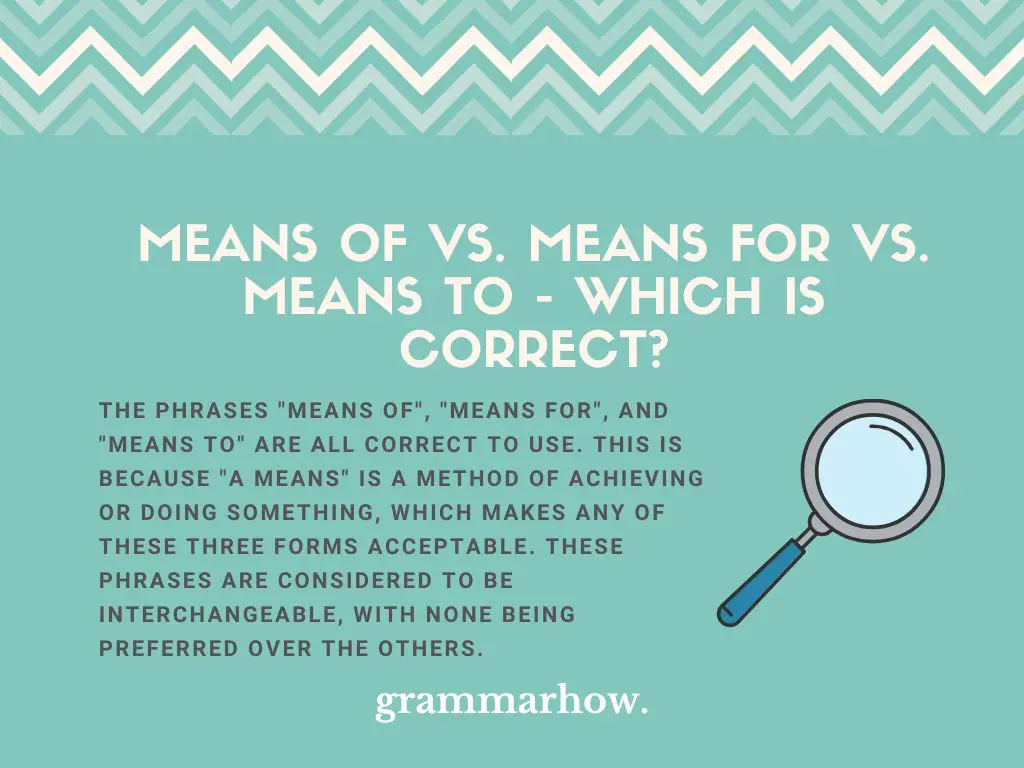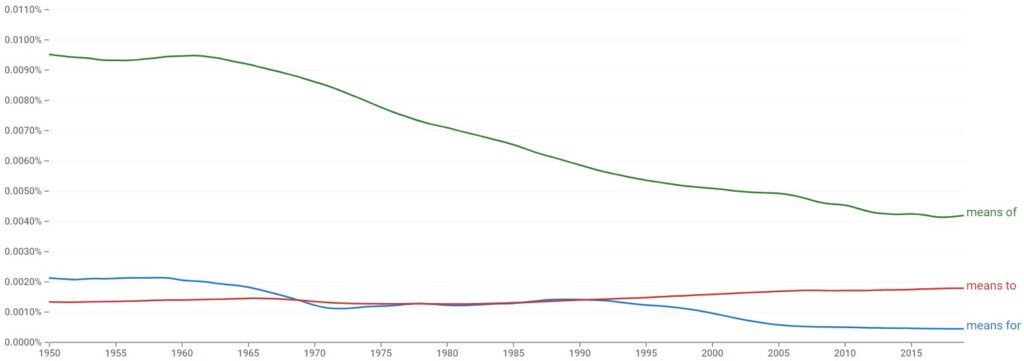The phrases “means of”, “means for”, and “means to” are seemingly quite consistent – with only the prepositions “of”, “for”, and “to”, creating a slight difference. In this article, we will be discussing the meanings and correct use of each of these phrases, to clear up any confusion.
Means Of Vs. Means For Vs. Means To – Which Is Correct?
The phrases “means of”, “means for”, and “means to” are all correct to use. This is because “a means” is a method of achieving or doing something, which makes any of these three forms acceptable. These phrases are considered to be interchangeable, with none being preferred over the others.

We can look over the following example that highlights how these phrases share similar meanings and can, therefore, be used interchangeably:
- This is an effective means of finding new job applicants.
- This is an effective means for finding new job applicants.
- This is an effective means to find new job applicants.
As we can see, the phrases “means of”, “means for”, and “means to” are all applicable and create the same meaning in the sentence. However, depending on the specific phrase that we choose to use, the sentence structure will be changed to reflect the particular preposition that follows the term “means”.
Means Of
The phrase “means of” is used when we wish to discuss the method, technique, instrument, etc., that we have utilized in order to achieve, do or complete something. We use the preposition “of” to express the relationship between a part and a whole.
Because of this, when we use the phrase “means of”, we are highlighting the specific relationship between the method we have used, with the end result that we have achieved.
We will now look over some examples that highlight the use of the phrase “means of” in a sentence:
- The car platform was elevated by means of hydraulic legs and arms.
- Insects propagate themselves by means of laying eggs.
- The interpreter explained the test by means of using sign language.
- He supported his broken ankle by means of using crutches.
- She climbed the try by means of using a ladder.
- The train is a safe means of transportation in the winter.
- Have you got any means of identification on you?
Means For
The phrase “means for” is also used when we wish to discuss a method, technique, or instrument that we have used in order to accomplish or complete something. We use the preposition “for” to discuss the purpose or connection of something, in relation to something else.
Because of this, the use of the phrase “means for” is consistent with “means of”, as we are using it to showcase the relationship between the method that we have used, with the completion of the task at hand.
We can also use the phrase “means for” to discuss how the results of something will affect a specific person or group of people.
We will now go over the following examples, that show how we can appropriately use the phrase “means for” in a sentence:
- We should anticipate our problems, so that we may provide a means for reaching a solution.
- What this means for Todd, is that he will have to stay late after class.
- They view it as not only a means for freedom but also peace of mind.
- I’m not certain what this means for you, but for me, it means I need to leave.
- Management accounting is a means for finding productive solutions for the company.
- What this means for our future educators is entirely uncertain.
- We can ponder over the means for simplifying construction costs another time.
Means To
The phrase “means to” is used when we wish to discuss the method, technique, or tools used to achieve an end result. We use the preposition “to” to indicate movement, an action, or condition suggestive of movement, towards a person, place, or thing reached.
Because of this, the phrase “means to” can be used interchangeably with the phrase “means of” or “means for”, as it is also highlighting the relationship between actions, plans, etc., and the result that we wanted to or did achieve.
We can also use the phrase “means to” to discuss how something is important to an individual or a group of people.
We will now look over some examples that showcase how to properly use the phrase “means to” in a sentence:
- I view this as a means to the end of this horrible situation.
- These new laws are a means to fighting the ongoing gun violence problem.
- I know how much your boyfriend means to you.
- To be beautiful means to be just as amazing on the inside, as on the outside.
- She lacked the means to support her family, so she works two jobs.
- My teacher provided me with the means to pass my upcoming exam.
- He regarded his marriage as merely a means to an end.
Which Is Used The Most?
As we can see by the data provided by Google Ngram Viewer, the phrase “means of” is used more often than both the phrase “means for” and “means to”. This is a trend that can be seen as being consistent from the 1950s, into the present day.

The phrases “means for” and “means to” have been used quite consistently throughout the last half-century. From the 1950s to around the 1970s, the phrase “means for” was used slightly more often, however, after this timeframe, the use was nearly identical to “means to”. This continued until the 1990s, and then “means to” became more popularly used, but only marginally.
This trend could have a lot to do with the fact that “means for” and “means to” are used quite consistently, even in terms of discussing how something affects or is important to someone or a group of people.
Final Thoughts
The phrases “means of”, “means for”, and “means to” are all very consistent in both meaning and correct or applicable usage. Because of this, we can use all three of these phrases interchangeably, without causing any unnecessary confusion to an audience or specific recipient.
You may also like:
Mean or Means – Difference Explained (With Examples)
